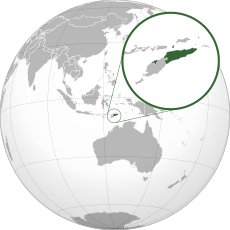မိူင်းတီႇမေႃးပွတ်းဝၼ်းဢွၵ်ႇ
(လုၵ်ႉတီး East Timor ၼႆႈသေ ၶိုၼ်းပိၼ်ႇဝၢႆႇမႃး)
မိူင်းၸွမ်ပွင်ၸိုင်ႈ တီႇမူဝ်ႇၶရႅတ်ႉတိၵ်ႉ တီႇမေႃးလႅတ်ႉသ်တႄး
| |||||
|---|---|---|---|---|---|
| |||||
| ၶေႃႈၶၼ်ပၢၵ်ႇ: Unidade, Acção, Progresso (Portuguese) "Unity, Action, Progress" | |||||
| ၽဵင်းၸိူဝ်ႉၸၢတ်ႈ: Pátria (Portuguese) "Fatherland" | |||||
 | |||||
| ဝဵင်းလူင် and largest city | Dili 8°33′S 125°34′E / 8.55°S 125.56°E | ||||
| ၽႃႇသႃႇဢၼ်ပဵၼ်တၢင်းၵၢၼ် | |||||
| National languages | |||||
| Working languages | |||||
| သႃႇသၼႃႇ (2015 census)[1] |
| ||||
| ၵူၼ်းၶိူဝ်းငဝ်ႈမိူင်း | |||||
| လူင်ပွင်ၸိုင်ႈ | Unitary semi-presidential republic[4] | ||||
| José Ramos-Horta | |||||
| Xanana Gusmão | |||||
| ၸုမ်းသၢင်ႈၵူတ်းမၢႆ | National Parliament | ||||
| Independence | |||||
| Early 18th century | |||||
| 28 November 1975 | |||||
| 17 July 1976 | |||||
• Administered by UNTAET | 25 October 1999 | ||||
| 20 May 2002 | |||||
| လႅၼ်တီႈ | |||||
• ႁူမ်ႈလေႃး | 14,950 km2 (5,770 sq mi) (154th) | ||||
• ၼမ်ႉ (%) | Negligible | ||||
| ႁူဝ်ၼပ်ႉၵူၼ်းမိူင်း | |||||
• 2023 estimate | 1,354,662 (153rd) | ||||
• 2022 census | 1,341,737[5] | ||||
• Density | 89.7/km2 (232.3/sq mi) (137th) | ||||
| GDP (PPP) | 2023 estimate | ||||
• ႁူမ်ႈလေႃး | |||||
• Per capita | |||||
| GDP (nominal) | 2023 estimate | ||||
• ႁူမ်ႈလေႃး | |||||
• Per capita | |||||
| Gini (2014) | 28.7[7] low inequality | ||||
| HDI (2022) | 0.566[8] medium (155th) | ||||
| ယူင်ႉငိုၼ်းတွင်း | United States dollarb East Timor Centavo (USD) | ||||
| ပွတ်းတွၼ်ႈၶၢဝ်းယၢမ်း | UTC+9 (Timor-Leste Time) | ||||
| ပိူင်ႁေႃႈလူတ်ႉ | Left | ||||
| ၶူတ်ႉႁွင်ႉၽူၼ်း | +670 | ||||
| ISO 3166 code | TL | ||||
| ဢိၼ်ႇထႃႇၼႅတ်ႉ TLD | .tlc | ||||
| |||||
ၽိုၼ်ဢိင်
မႄးထတ်း- ↑ Nationality, Citizenship, and Religion. Government of Timor-Leste (25 October 2015).
- ↑ Hicks, David (15 September 2014). Rhetoric and the Decolonization and Recolonization of East Timor. Routledge. ISBN 9781317695356.
- ↑ Adelman, Howard (28 June 2011). No Return, No Refuge: Rites and Rights in Minority Repatriation. Columbia University Press. ISBN 9780231526906.
- ↑ Shoesmith, Dennis (2003). "Timor-Leste: Divided Leadership in a Semi-Presidential System". Asian Survey 43 (2): 231–252. doi:. ISSN 0004-4687. “The semi-presidential system in the new state of Timor-Leste has institutionalized a political struggle between the president, Xanana Gusmão, and the prime minister, Mari Alkatiri. This has polarized political alliances and threatens the viability of the new state. This paper explains the ideological divisions and the history of rivalry between these two key political actors. The adoption of Marxism by Fretilin in 1977 led to Gusmão's repudiation of the party in the 1980s and his decision to remove Falintil, the guerrilla movement, from Fretilin control. The power struggle between the two leaders is then examined in the transition to independence. This includes an account of the politicization of the defense and police forces and attempts by Minister of Internal Administration Rogério Lobato to use disaffected Falintil veterans as a counterforce to the Gusmão loyalists in the army. The December 4, 2002, Dili riots are explained in the context of this political struggle.”
- ↑ Population by Age & Sex. Government of Timor-Leste (25 October 2015).
- ↑ 6.0 6.1 6.2 6.3 World Economic Outlook Database, October 2023. International Monetary Fund (October 2023).
- ↑ Gini Index coefficient. CIA World Factbook.
- ↑ HUMAN DEVELOPMENT REPORT 2023-24 (in en) 274–277. United Nations Development Programme (13 March 2024).

